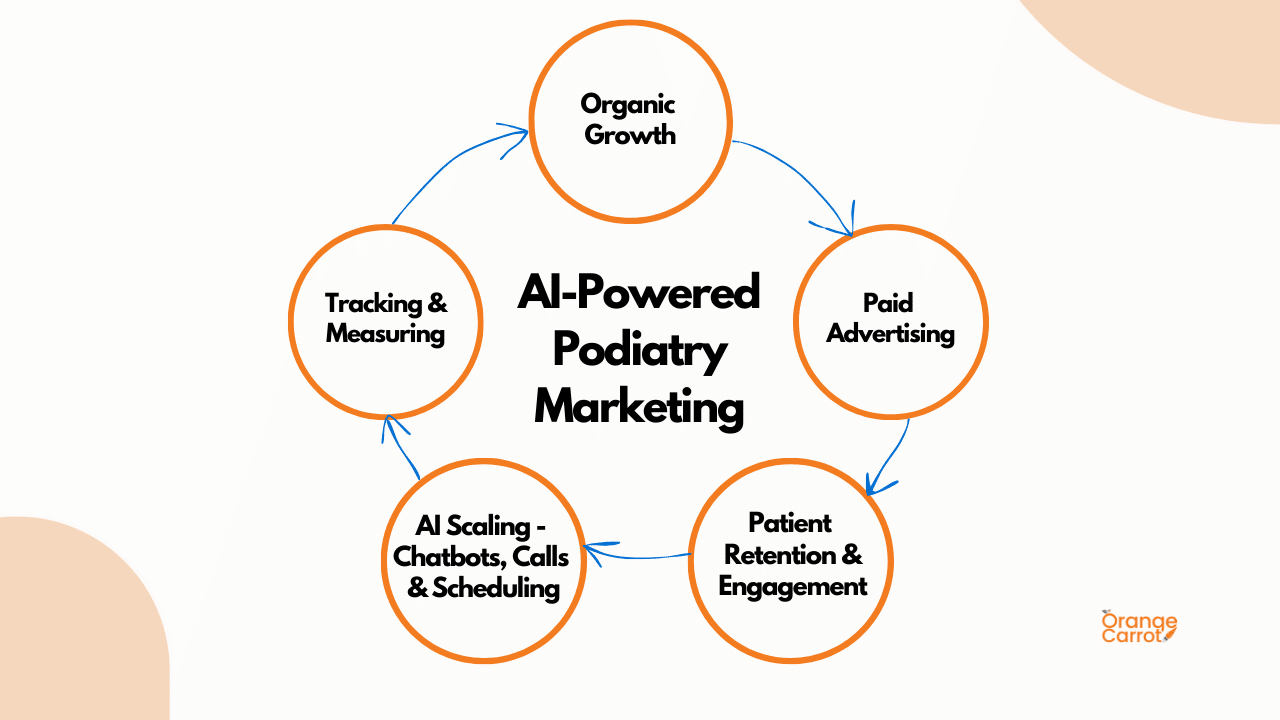
Podiatry marketing is changing in the digital age and AI is leading the charge. From patient acquisition to retention, AI is changing how podiatrists grow their practices and connect with their patients.
Today, we are sharing 7 AI-driven marketing strategies for podiatrists. These aren’t just text-book notes, these are practical tips that will boost your online presence, attract more patients and increase brand loyalty (from existing patients). Here, brand refers to your practice brand or clinic brand.
The blog covers everything from building a strong digital foundation to using advanced AI tools to scale your practice. And how our team can help you integrate these tools seamlessly.
You will also learn how AI turbo charges paid advertising, content creation and much more.
Whether you are an experienced podiatrist or just starting out, this guide will keep you up to date with the AI-powered approach to healthcare marketing, specifically podiatry marketing.
All successful podiatry marketing campaigns start with a strong digital platform. The point to keep in mind is that AI tools are assistants, not substitutes. Foundational digital marketing activities must be taken care of, to begin with.
A properly designed website serves as a virtual storefront. It’s quite likely the initial impression prospective patients will have of your practice.
Since a majority of web traffic today comes from mobile devices, adopting a mobile-first design for podiatry websites is no longer optional—it’s a necessity.
A mobile-optimized website should:
Starting from July 1, 2019, mobile-first website indexing became the default for all new websites.
So, if Google is prioritizing mobile-first, so should you if you’re serious about your podiatry brand. It clearly impacts SEO rankings and overall visibility.
Then comes the speed.
Here’s the results of the speed test for one of our client’s website:
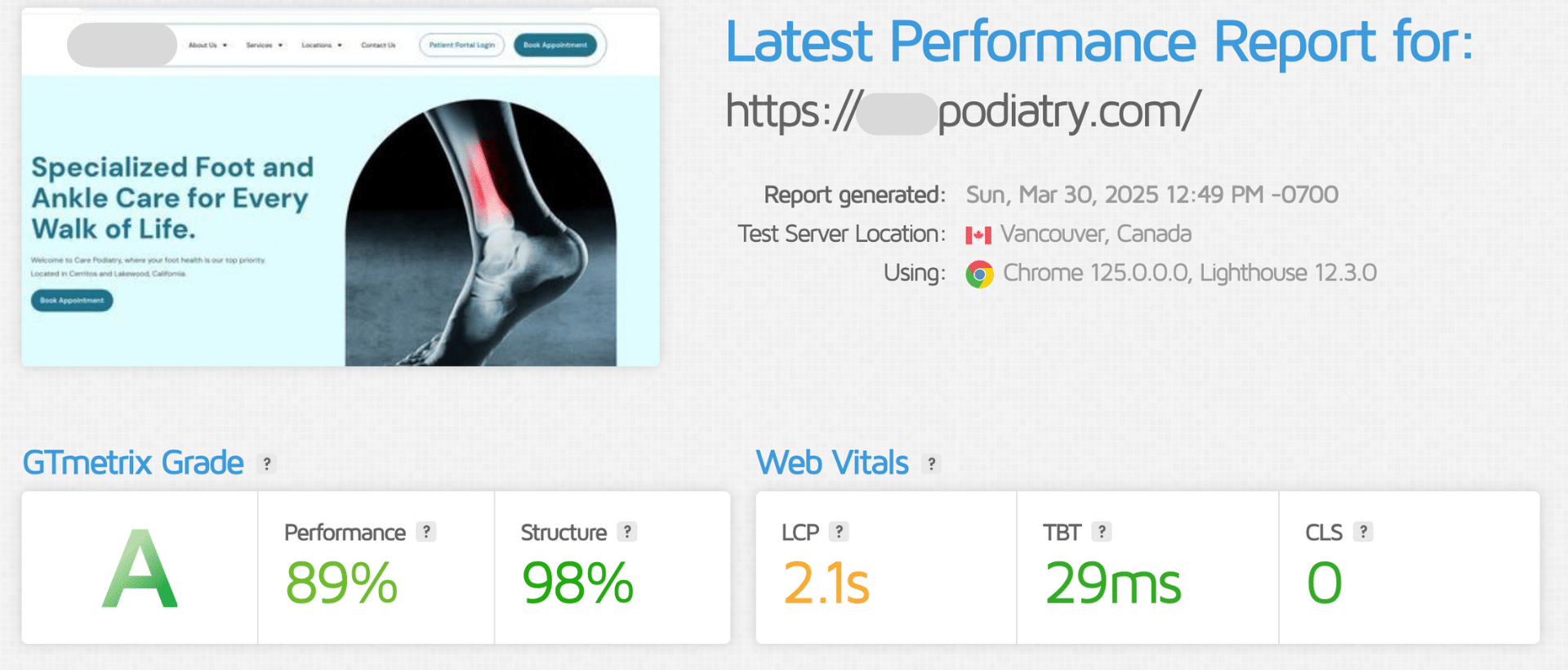
A fast-loading, mobile-friendly website is ideal – both from user and Google’s point of view. A study by Marketing Dive shows that users abandon websites that take more than 3 seconds to load, making speed a critical factor for online success.
Technical optimization techniques such as image compression, caching, and minimizing unnecessary scripts help reduce load times, ensuring visitors don’t leave due to delay.
Don’t worry if technical SEO concepts are too overwhelming to understand. Orange Carrot search experts can help you get clarity. Reach out to us for a free consultation about your website’s page speed.
Beyond speed and mobile responsiveness, conversion-focused UX plays a key role in turning visitors into customers. A well-structured layout with clear calls-to-action (CTAs), simple navigation, and persuasive messaging helps patients in purchasing a podiatry-kit (for example), booking a foot service, or contacting patient support directly.
All the information should be readily available for your website visitors. This also helps Google bots to crawl your website easily.
Since podiatry marketing is now AI-focused, our team also implements tools like Hotjar AI to analyze user behavior on the website and optimize even better.
We already discussed technical SEO optimization in the above section. Apart from that, there are on-page SEO factors to take into consideration.
On-page optimization done right, helps to improve overall CTR of a website from search engines. Retaining that traffic is done by thorough content optimization strategies, which we’ll discuss further.
On-page SEO optimization includes:
Next comes the local SEO. Local or location-based marketing is so important to make podiatry practices more visible to nearby patients. Through optimizing for local search terms, podiatrists are able to show up in local searches that matter to them.
Here’s an example of the impact our strategy had for a podiatrist client—within just one month of implementation, they started ranking for ‘podiatrist near me’ and related keywords, as shown in the screenshot below:

Results like this involve a thorough local SEO plan focused on improving local visibility and search rankings.
Once the optimization is set up and on-going, the next priority should be to offer seamless user experience for your prospective patients. This includes a mobile-friendly fast-loading site, easy-to-understand contact information, convenient patient portals and bill payment options.
Together, all of these components make a perfectly optimized website ready for success.
Read more about local SEO for podiatrists in depth.
Content marketing is a great way to establish credibility, educate people, and promote organic traffic. If properly executed, it increases brand authority and turns readers into loyal patients.
Today, it’s easier to create great content with the help of AI-powered tools, but with caution.
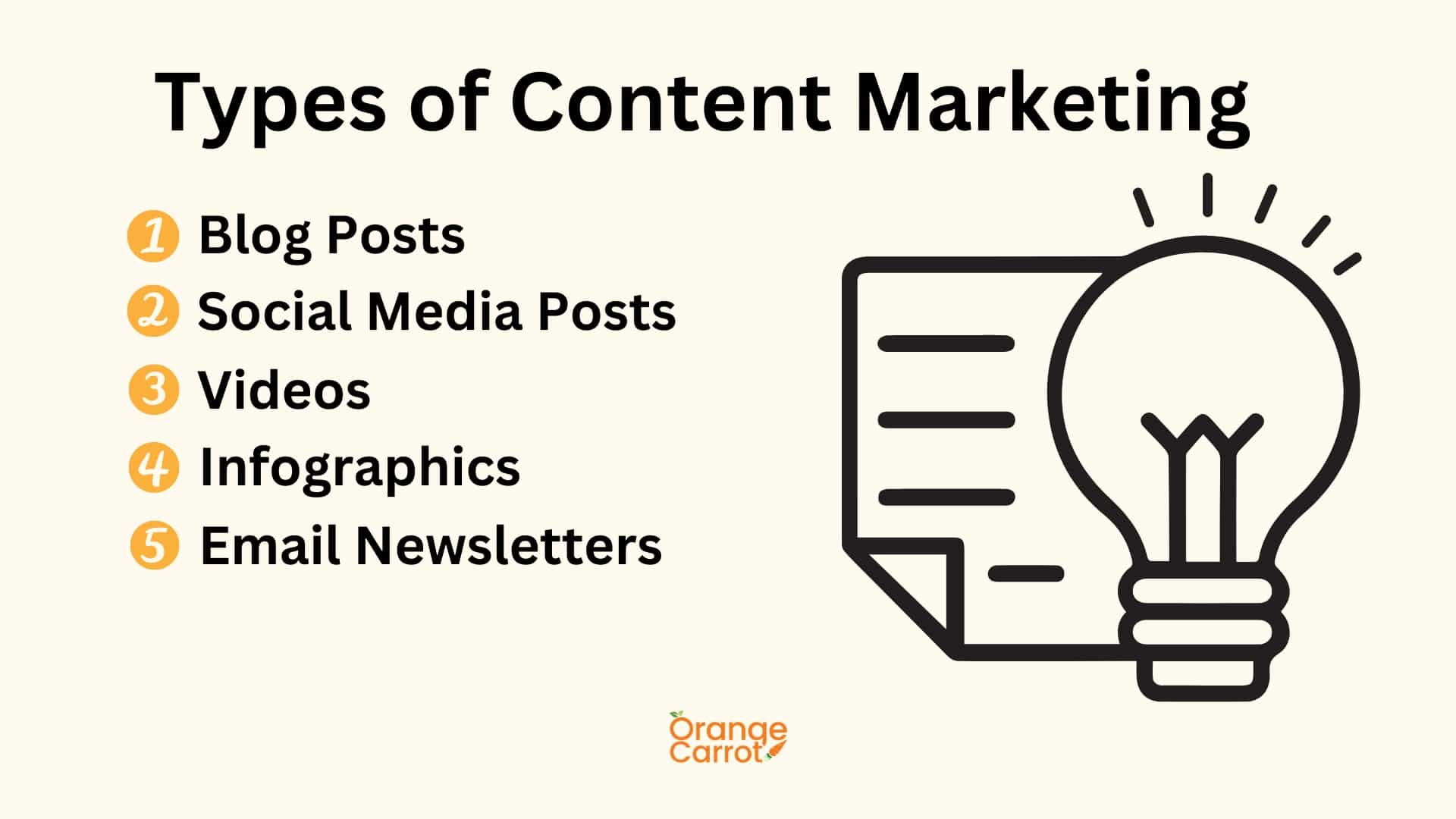
Content marketing has two elements in it – value-adding and SEO-optimized.
SEO-optimized blog content is important to enhance search visibility and get attention from the relevant audience. But there’s no use writing blogs that are just optimized for search engines, if it doesn’t add value to the readers (in this case potential patients).
A well-written blog is a perfect blend of SEO and educational content for users on foot-health topics. This is something only an experienced podiatrist can write, compared to generic writers.
You can still outsource the writing to medical writers and QA before publishing. This makes it more trust-worthy when ‘Podiatrist-Recommeded’ is added to the title.

Keyword Research & Intent Matching: Understanding what your audience is searching for is the first step. Tools like Google Keyword Planner, SEMrush, and Ahrefs help to identify keywords related to user intent—whether informational (“What are the symptoms of plantar fasciitis?”) or transactional (“Best podiatrist near me”). Then you can plan the blog topics accordingly (along with headings).
Compelling Headlines & Subheadings: Structuring the blog content with H1, H2, and H3 tags – making it easy for users to read. A clearly structured content is so much easier for search engines bots to crawl as well.
A good headline should be keyword-rich yet engaging. For example:
Weak: “Foot Pain Treatment”
Strong: “10 Proven Ways to Treat Foot Pain Naturally (Podiatrist-Recommended)”
Content Depth & Readability: Google favors authoritative, in-depth content that answers user queries elaborately. Blog posts should be at least 800–2000 words. Include bullet points, numbered lists, and visuals, etc and maintain a conversational yet informative tone. This enhances the content readability making the users stay on the website longer.
Internal & External Links: Linking to authoritative sources (e.g., Mayo Clinic for medical content) improves credibility. It means that you have done proper research to support the claims you’re making in the blogs. Support this by linking internally to other content like your own service pages, other blogs etc wherever it makes sense. Internal links keep users engaged and also help to create proper overall website hierarchy.
Multimedia & UX: Including relevant images, infographics, and videos not only enhances engagement but also boosts rankings in image and video searches.
Call-to-Action (CTA): Every blog post should encourage action, whether booking an appointment, signing up for a newsletter, or downloading a foot health guide.
Example of a good CTA is:
“Struggling with foot pain? Book a free consultation with our podiatry expert today.”
Overall, a well-structured, SEO-optimized content improves search engine visibility, keeps readers engaged, and increases podiatry practice growth.
You know how to write a perfect SEO optimized content but let’s see how AI can help in this process.
AI tools like ChatGPT, Ahrefs, AnswerThePublic, help to generate content ideas, outlines, and summarize research reports quickly.
Take this blog for instance. we used ChatGPT to get the idea for blog headings (being honest with our readers). After multiple iterations and of course manual editing, we finalized the blog headings and started writing the content for it.
What AI cannot do is write this content – like the case studies we presented, the 5+ years of experience we have working with podiatrists.
This is the typical example of how to use AI – for ideation, research and planning but not the actual writing.
As a podiatrist, you bring a unique perspective to your blog content. Something that AI can never do. Using AI content for blogs and website content can heavily penalize your website. It may even lose credibility and rankings in the long-run.
Similarly, AI can also be used to optimize existing content – to add more key phrases for better rankings. You can also use tools like Grammarly and Hemingway Editor to refine sentence structure, readability, and tone to match audience expectations. All this is part of optimization but not writing.
As mentioned above, AI-generated content lacks the brand voice, originality, and subject matter expertise; making it feel generic or robotic. This is especially problematic in storytelling and brand-building efforts.
The Risk of Over-Optimization – some AI tools overstuff keywords, producing content that reads unnaturally and may trigger Google’s spam filters, hurting rankings.
Here’s the Google Search Console screenshot of one of our podiatry client websites:
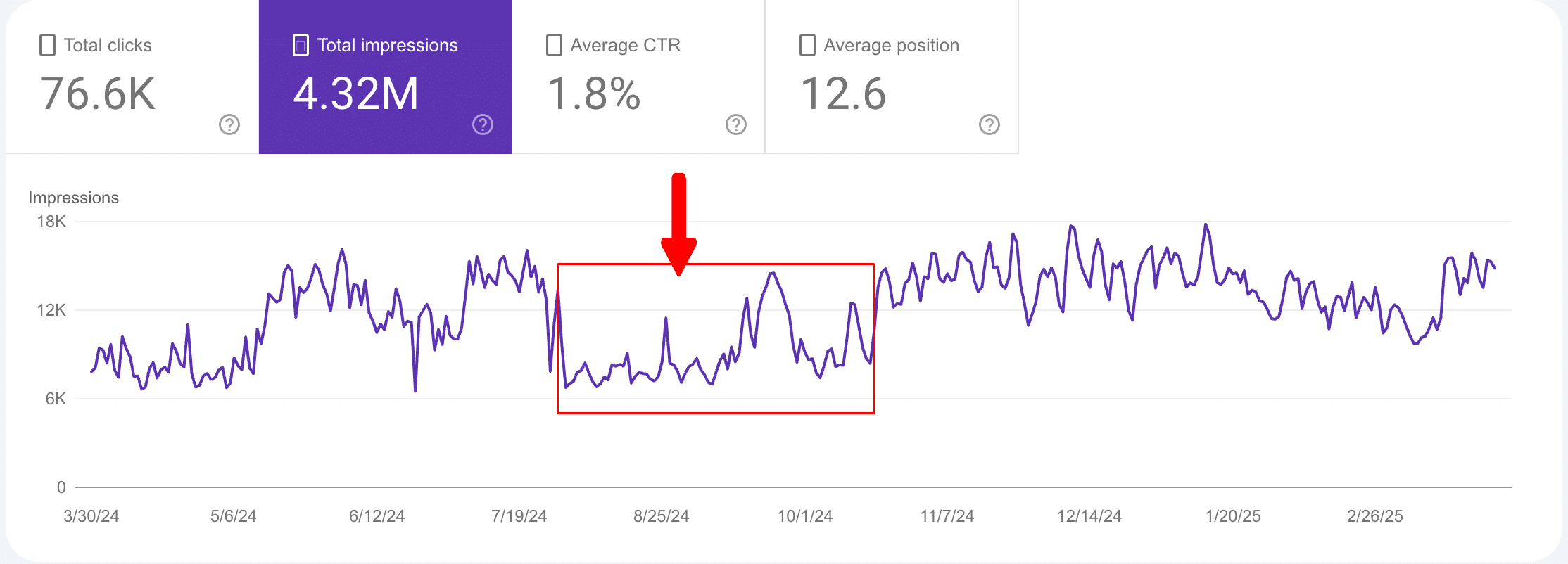
We noticed the doctor was using ai content for blogs. And it immediately impacted his Google rankings. We alerted him and replaced it with human-written content without ai images. Since then, we have been actively monitoring client websites, especially when the client handles content publishing.
Pro Tip: Audit your website at least once a month manually and use tools to remove any ai-generated content (copy, images etc).
Inaccurate or Outdated Information – AI models rely on pre-existing data and may produce misleading or outdated information, particularly in sensitive fields like healthcare. There should be heavy fact-checking by a podiatrist who’s publishing those blogs. It’s altogether best to avoid any form of ai content.
The content spin problem – rewriting the same content written somewhere else, we call it content spinning, isn’t very helpful to establish authority at all. Users already read that content elsewhere. So it doesn’t add value whatsoever.
So the best approach is AI Ideation + Human Collaboration.
Connect with us to get a customized content marketing plan for your podiatry clinic practice.
Social media for podiatrists refers to the use of online platforms like Facebook, Instagram, and LinkedIn, YouTube, TikTok etc — to share valuable information on foot health, engage with current and prospective patients, and establish a brand.
A well-planned social media strategy is important for building a brand and attracting new clients. Unlike paid social ads, organic social media plan focuses on creating genuine human interactions and lasting relationships. While paid ads increase the reach through targeted placements, which we’ll discuss in the next section.
Take a look at the Instagram grid of one of our podiatrist clients. This was designed exclusively as per the doctor’s requirements.
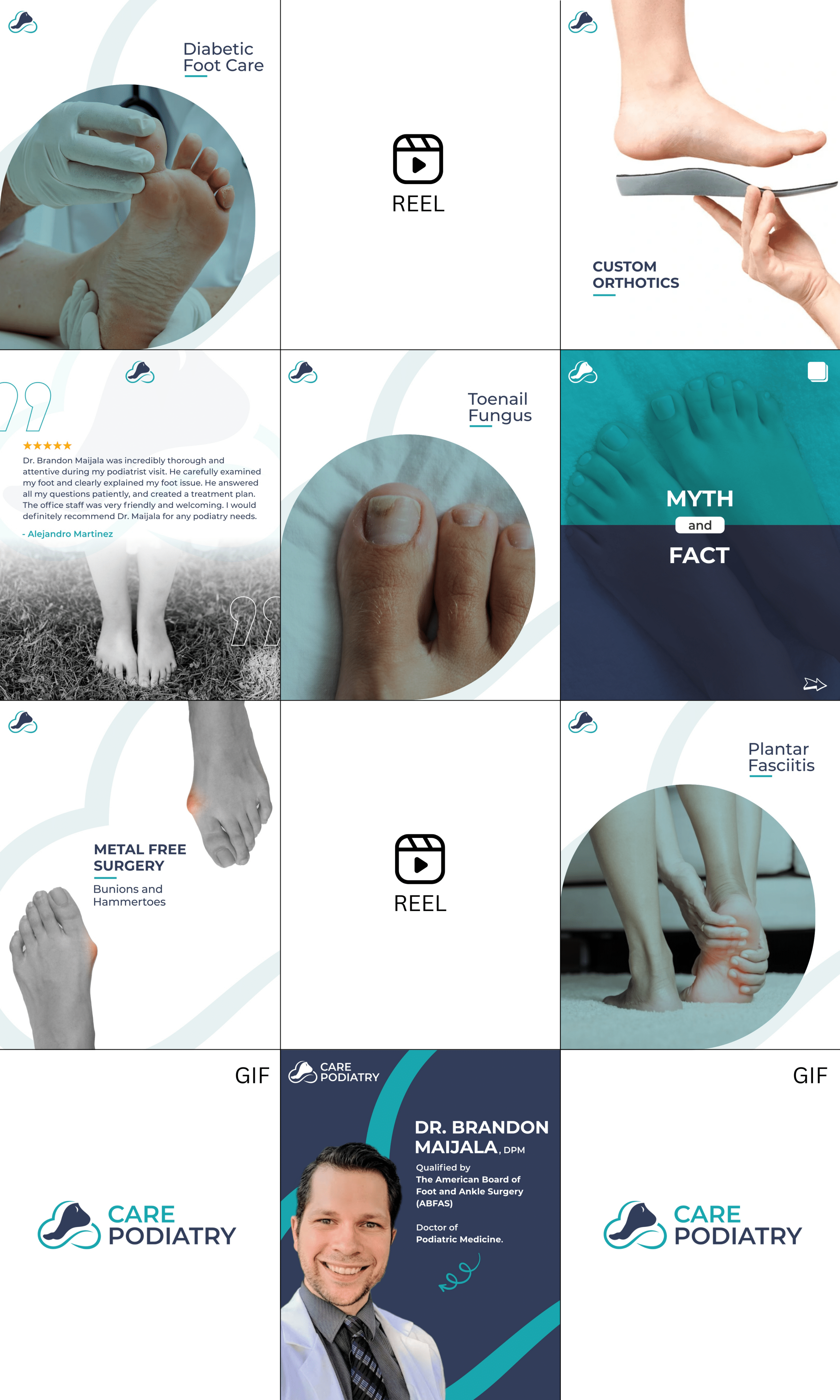
Patient education should come first. Answer commonly asked questions, describe common foot conditions, and offer foot care advice. Make use of brief videos, infographics (yes, they still work if done right), and posts that people can understand – and relate to.
For instance, you can post something like this “Heel pain? Plantar fasciitis could be the cause! Here’s how to get relief.”
You can also share patient success stories. Credibility and trust on a doctor comes from hearing actual patient experiences. Display before-and-after photos to demonstrate the effectiveness of treatments (with patients’ consent of course).
Remember to also include behind-the-scenes content. Share clinic updates, introduce doctors, or show off your team at work. This makes your practice feel more human and helps patients feel more connected.
Podiatrists can also run occasional polls, Q&As etc to get real data. These type of posts may or may not get a great engagement (especially for beginner accounts), but keeps the account active.
Ask questions like, “What’s your biggest foot health concern? Comment below, and we’ll answer in our next video!” Posts like these keep your social channels interactive and give an opportunity to actually address their concerns.
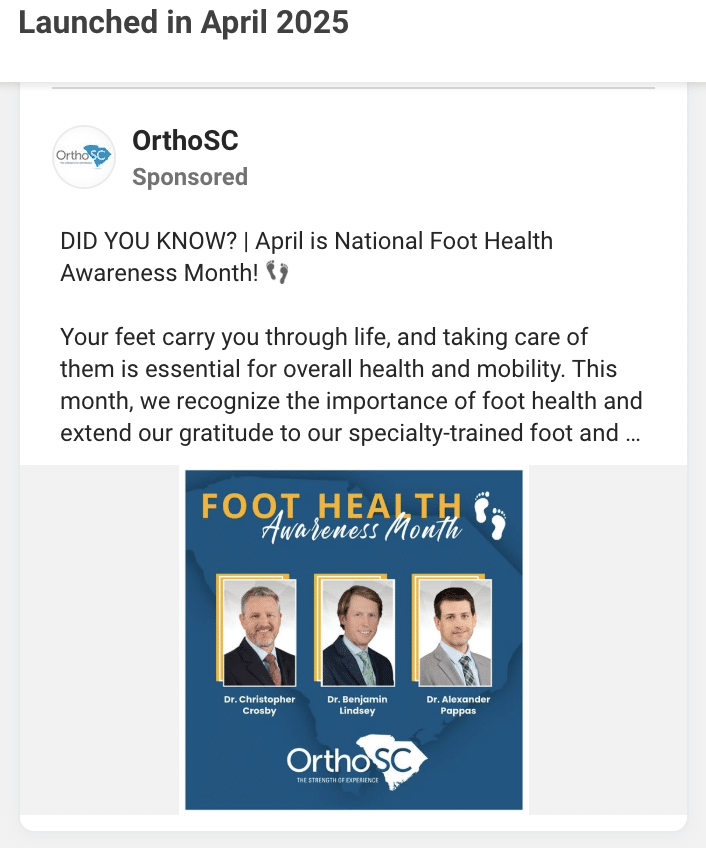
Seasonal promotions or awareness campaigns also work well. For example, April is Foot Health Awareness Month. According to the American Podiatric Medical Association, approximately 20% of the U.S. population has at least one foot problem annually. Foot health awareness posts are super effective in establishing you as a trusted expert in podiatry.
You could post, “Book a consultation this month and get a free foot assessment!” Limited-time offers encourage people to take action.
AI Tools can help with ideation, scheduling posts, tracking user engagement or even planning the content. With platforms like Meta Business Suite and HootSuite we can be consistent with posts and not miss a schedule. You can even use social listening tools such as HootSuite, Sprout Social for ideation.
But here’s the thing – real engagement with users requires human touch.
Here’s a few examples of AI commenting gone wrong:
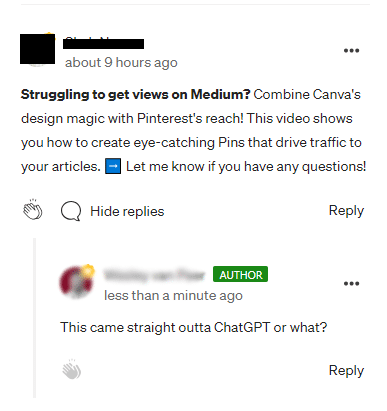

Some things should never be automated. Commenting on posts, replying to the comments, patient stories and testimonials etc., must feel authentic. A heart-felt patient story must always come from real experience.
People are smart enough to detect AI content and it affects your brand reputation.
When engaging with the social media community, make it personal. Even though some replies like “We received your message and we’ll get back to you shortly” or “DM us for more updates” can be posted using AI, the further conversation has to be continued by a front-desk help assistant or podiatry-assistant.
Also, podiatrist insights and health advice must also be presented by the practitioner. Instead of an AI-generated post or captions (although we can use it occasionally), create a video of you providing foot care tips.
Use AI for scheduling, tracking or reminders. But keep the human element intact in all your online interactions.
Social media is not just about posting – it is about building a real brand, brand loyalty and lasting relationships.
Let us do the marketing while you concentrate on your podiatry practice. Book a free strategy call with us.
While organic search marketing is for long term growth, paid ads bring quick results. Within 2-3 months, podiatrists can see decent patient growth. Attracting new patients requires a strategic approach to paid advertising.
Let’s look at the platforms used for podiatry advertising.
Google is the most powerful platform to reach high-intent audiences searching for podiatric care. This is where actual integration with AI begins.
Google has significantly integrated AI into its advertising, with over 90% of campaigns using machine learning. Smart Campaigns and Performance Max Campaigns are fully automated using Google’s AI – to optimize bidding, budget allocation, audience targeting, and optimize creative elements.
By combining precise keyword targeting with AI-powered audience refinement, podiatrists can consistently generate leads while optimizing their ad spend over time.
Google also offers Local Services Ads (LSAs) for medical practitioners (including podiatrists), which is a pay-per-lead advertising service that can help medical practices reach potential local patients searching for their services.
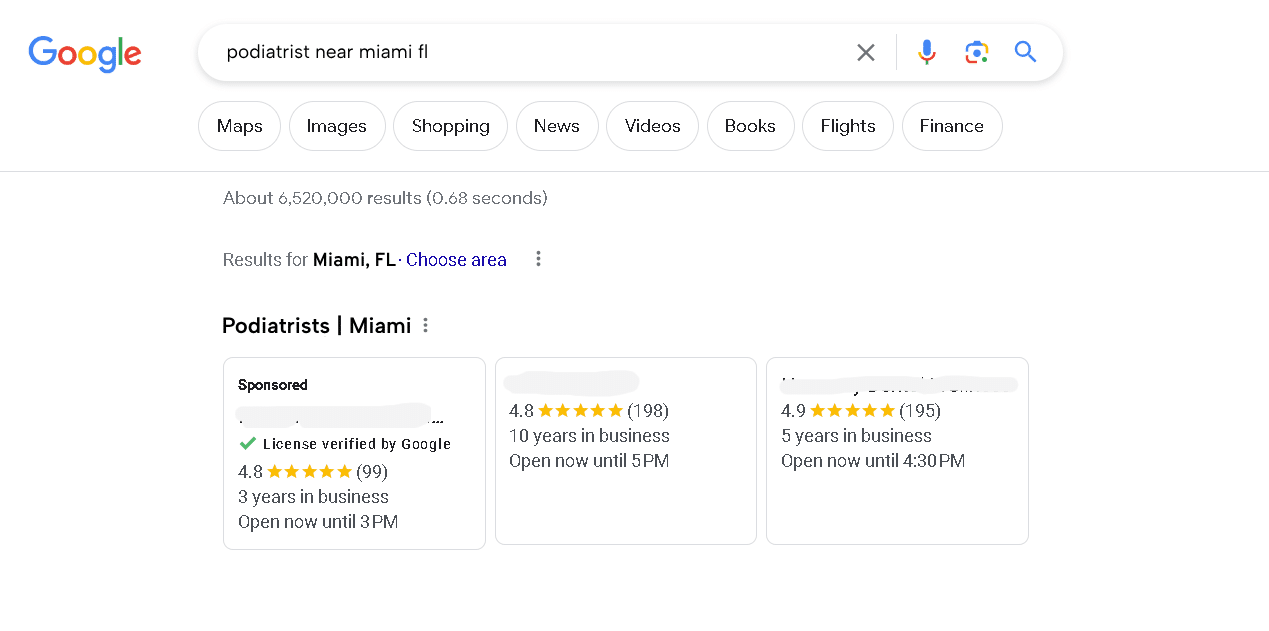
Podiatry LSA ads are different from regular Google Ads, in the sense that LSAs will get a ‘verified business badge’ by Google at the top of search results with details such as ratings, reviews and a direct phone number. This of course requires a thorough documentation, verification and approval from Google which takes a couple of weeks.
For podiatrists specifically, these ads provide increased visibility from high-intent patients searching for same-day foot care. For such ads, Google charges the podiatrists only for qualified leads.
By utilizing both Google’s Local Services Ads (LSAs) and geo-targeted PPC campaigns, podiatrists can ensure that their practice appears at the top of search results for potential patients in their area. According to Google’s internal data, 72% of people who perform a local search visit a store or business within five miles—highlighting the importance of localized ad placements.
Another form of advertising on Google is through the Google Maps Pack (Local pack).
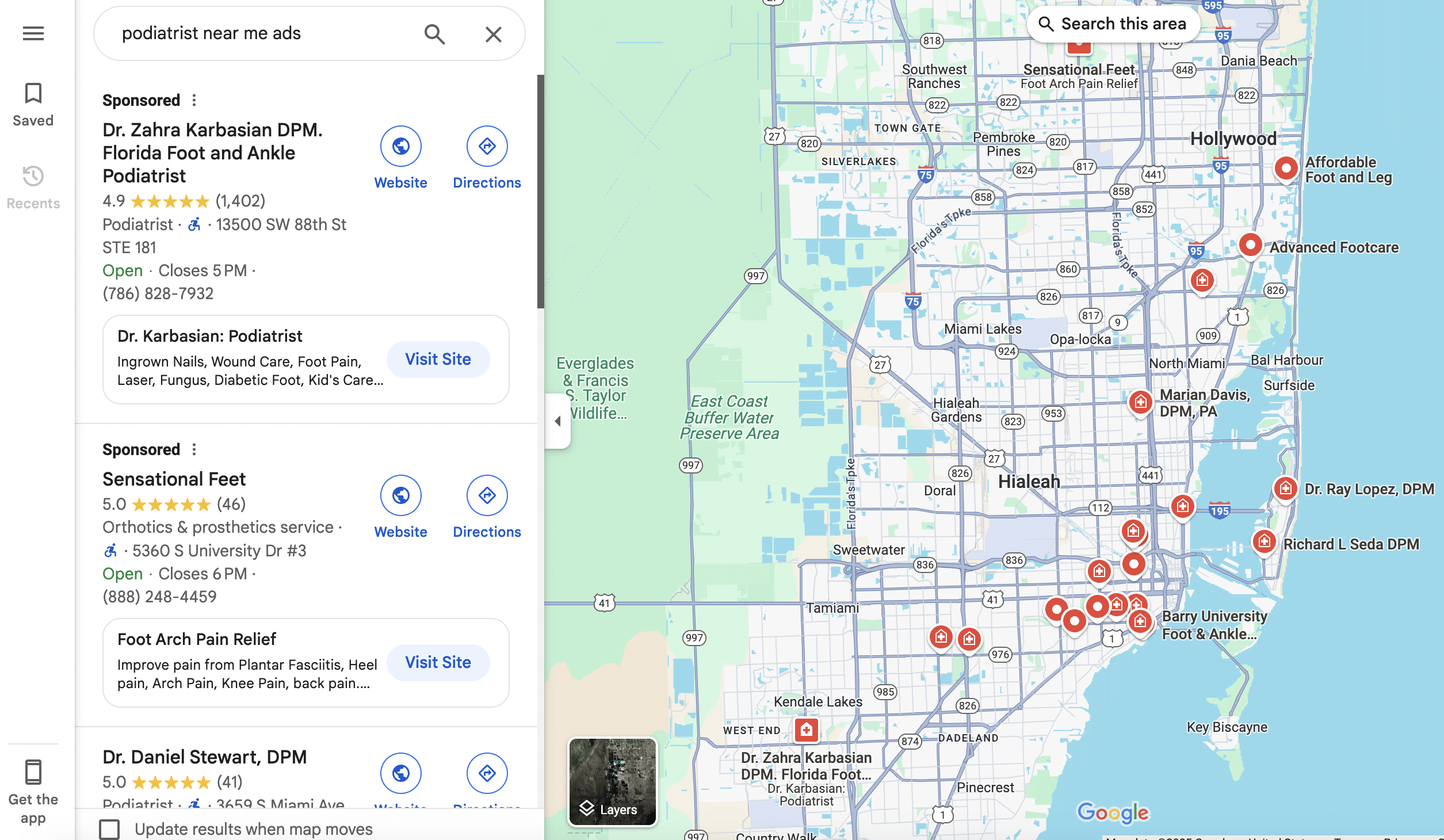
These ads allow businesses to be featured at the top of local search results with a map listing. These ads help podiatry clinics with high visibility when users search for local foot and ankle clinics etc., as it shows their map location, reviews, and contact numbers.
Here an example of Facebook lead ads for podiatrists:
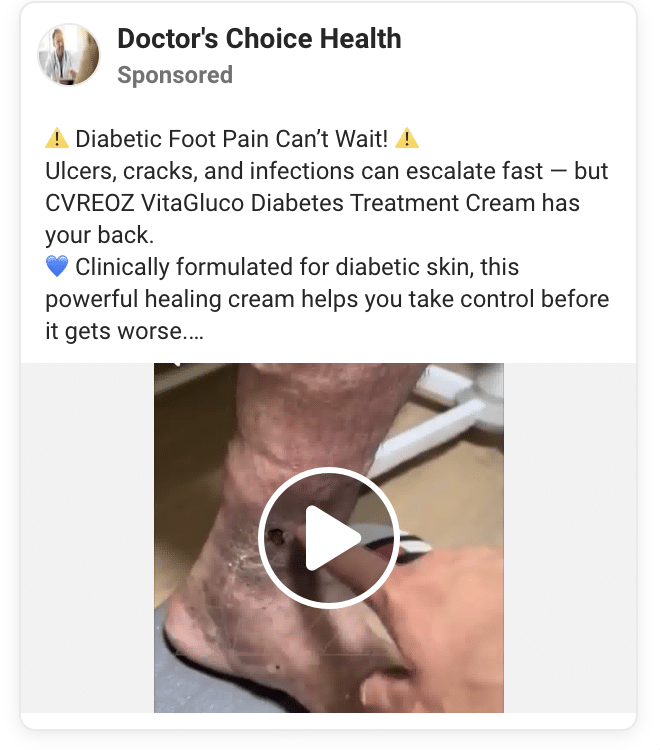
The lesser known advertising for podiatrists is done on the Meta platform (Facebook & Instagram). Meta’s AI smartly refines the audience targeting, but manual ad testing is essential in the early stages.
Let’s take a closer look at what type of Facebook ads work for podiatrists, and what the process is.
Short video ads of 30-60 seconds can address the most common foot and related issues (heel pain, bunions, etc.), educate the patient, and build credibility.
A video titled “Signs You Need a Podiatrist” can explain some of the signs/symptoms and preventive measures to take while ending with a very strong call to action (CTA) like “Are you suffering from foot pain? Schedule today!”
A carousel ad that indicates some before and after photos showing correction from bunions, toenails with fungus, or care of diabetes can visually illustrate what to expect.
Each slide could be educational, but link easily to schedule an appointment with captions like “Sick of foot pain? Let’s fix it – schedule your appointment today!” or something similar.
Utilize Facebook’s extensive targeting to find the appropriate audience of patients like: runners, diabetics, and living within a certain radius (5-10 miles) etc.
If a visitor to your website goes to the SERVICES page, the ad can be a follow up to motivate them to engage, book, and again using the incentive “Limited Availability! Schedule your consultation today!”
Use patient testimonials in image and video formats in Facebook advertising.
Here’s a video testimonial we used for both Google and Facebook ads for our podiatry client:
A testimonial ad with a message like “I battled heel pain for years—until I visited Dr. Smith. Now, I walk without pain!” and then “Book Your Appointment Today” can generate genuine engagement from the ads.
A/B testing headlines, creatives, and CTAs help to optimize the campaigns. Testing variations such as “We Can Help with Your Plantar Fasciitis Pain” in comparison to “Having Trouble Walking Without Pain? Let’s Fix That” can make a huge difference in the Click-Through-Rate.
Meta’s AI-driven tools such as Advantage + Audiences gradually learn which demographics, interests, and behaviors result in the most conversions, allowing for smarter budget allocation.
Overall, podiatrists can take advantage of Facebook ads using different forms of educational content, engaging visuals, geo-targeted ads, and testimonials to acquire new patients.
Successful advertising requires a balance between manual optimization and AI-powered automation.
Over-relying on automation without understanding what works, can waste ad spend. Irrespective of the ad platforms we use, Orange Carrot team begins with manual budget bid adjustments, testing creatives and identifying high-performing ads before using AI’s insights. This helped us to carefully optimize the ad spends in the early stages of the campaigns.
Prioritize high-intent search terms such as “best podiatrist near me” and target the audiences by demographics, location, and engagement to capture ready-to-convert patients.
After 3-6 months, spend the budget wisely based on the historic campaign performance (at least 3 months of data is required). Bid on the services that are known to bring patient conversions, such as bunion treatments or custom orthotics depending on your podiatry business goals.
If you are uncomfortable with manual bidding or enhanced CPC bidding, you should try the Maximize Conversions or Target ROAS options for budgeting. But be sure to switch to automation after developing the baseline.
If you’re a podiatrist and require advertising, book a free strategy call with our team. We can guide you through this process.
Gain new patients — yes, but creating long-term relationships with existing patients is what really fuels growth for podiatry clinics. In the digital-first era, patients expect prompt communication, personalized treatment, and a frictionless experience at each touchpoint.
With the help of AI and automation, podiatrists can now match (and surpass) such patient expectations more effectively than ever before.
This section explains the ways in which growing practices can utilize AI and automation to boost patient satisfaction, and win back lost leads — all without sacrificing that personal touch needed to establish trust.
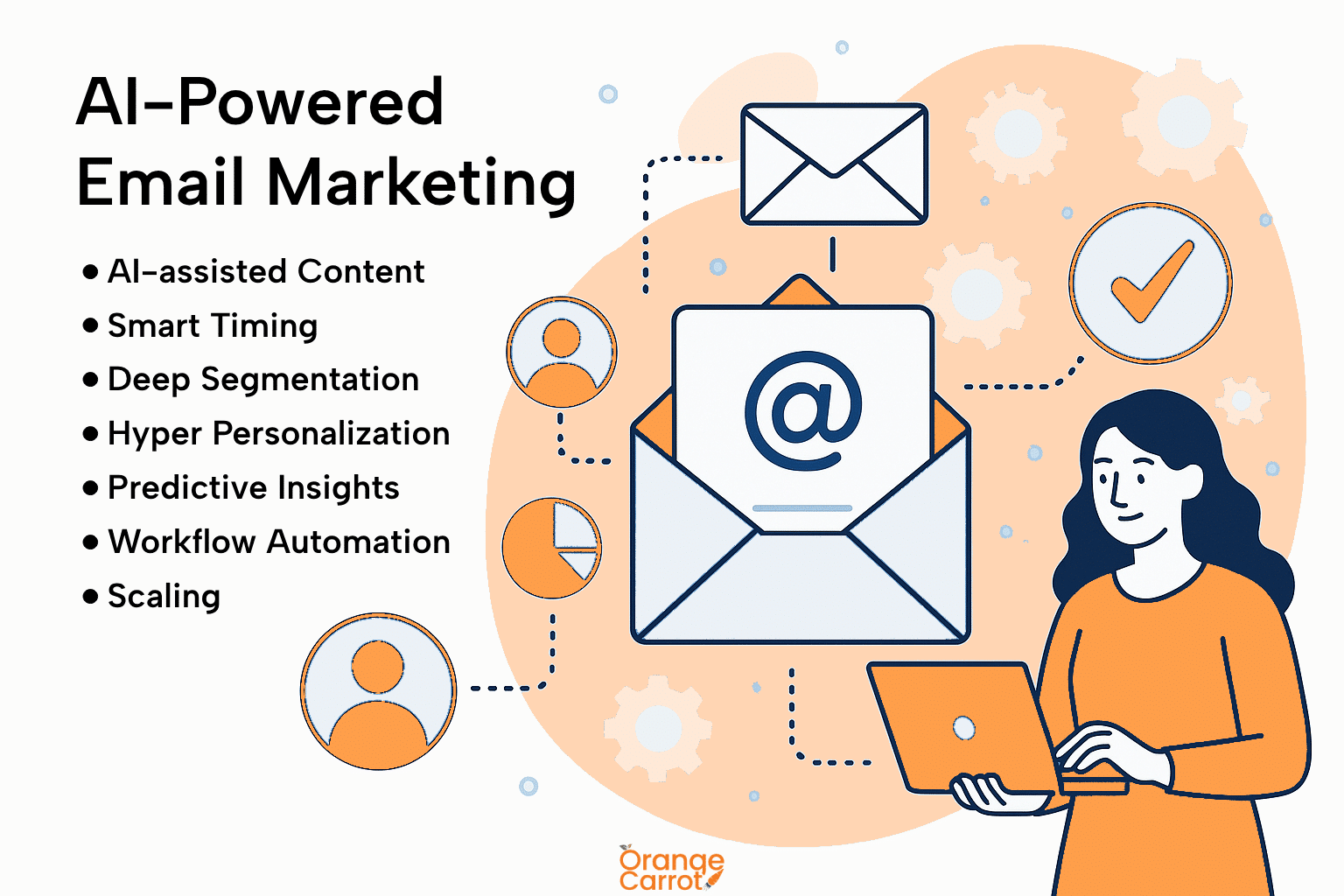
Email marketing is a powerful form of digital communication, and the introduction of Artificial Intelligence has revolutionized how brands connect with their audiences. It’s literally your first-party data that you own as a podiatrist without middlemen (big medical corporations who usually gatekeep the patient data).
From improving open rates to delivering hyper-personalized content, AI is transforming the way we can create, manage, and scale email campaigns. Whether you’re a beginner or an experienced practitioner looking to scale, AI can offer tremendous value at every stage.
At the starter level, AI enables us to implement smart campaigns from day one. AI tools eliminate the guesswork in content creation and campaign timing.
AI-powered subject line generators can create engaging and high-performing headlines based on millions of data points — boosting open rates early on.
AI also looks at user behavior to identify the best send times for each individual, so your podiatry emails arrive when they have the greatest chance of being read.
Smart segmentation options enable you to segment your audience beyond the basic demographics, considering user activity, device type, and even geolocation etc.
AI can also propose personalized content blocks — greetings, service recommendations, and so on — from and to various audience segments.
Overall, AI email marketing allows you to build data-driven, successful campaigns with little manual labor.
Then, as your podiatry practice scales and you have more patient data, AI-powered scaling opens up a whole new dimension of marketing opportunities.
AI is now able to forecast user behavior from previous interactions so you can deliver the right message at the right moment. But this is a very advanced feature probably used by corporate podiatry hospitals, and may not be necessary at a clinic-level practice.
For instance, AI is able to predict who will buy (say an anti-fungal kit), unsubscribe, or become inactive, and you can step in with content that re-engages or converts them. We’ll discuss more about this in 5.3 section below.
AI-powered, behavior-driven workflows enable podiatrists to automatically send appointment reminders, reactivation emails for inactive patients, and follow-ups for recommended treatments or orthotics — all while continuously learning and optimizing for better engagement and patient response over time.

A good ‘patient experience’ doesn’t stop at the clinic — it carries on to how patients feel after leaving your clinic, and how they talk to others about your practice. With the competitive nature of today’s healthcare market, Google reviews and patient testimonials are the most powerful trust drivers for potential patients.
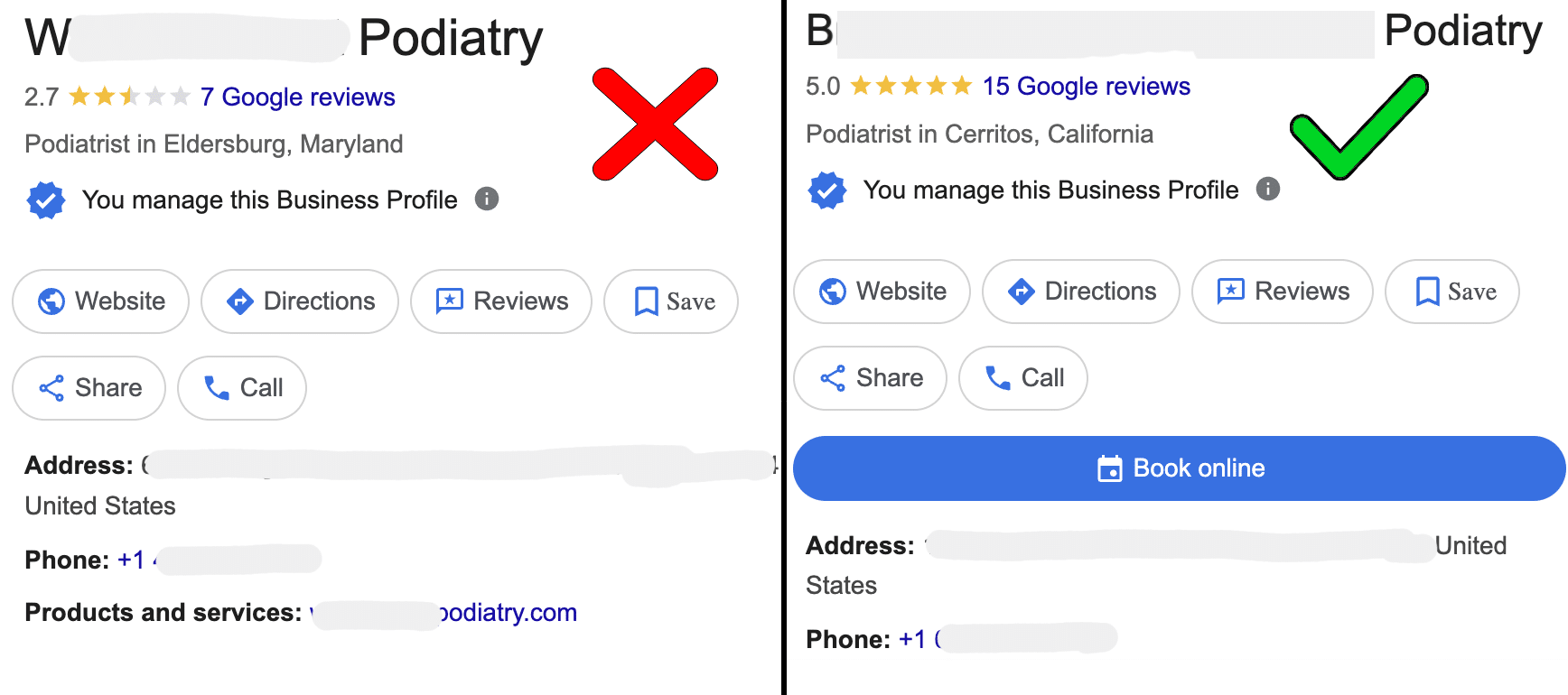
A good online reputation not only enhances your presence in local search but also increases credibility in the minds of patients looking for expert podiatric services.
Our podiatry practice marketing agency provides personalized solutions specifically created to enable podiatry practices to capture reviews automatically, and in bulk.
From soft reminders after visits to individualized review invitations by SMS or email, we make sure your happy patients are reminded to post their feedback on the sites that are most important to you.
Such systems operate quietly in the background, making it simple for patients to post a review while concentrating your staff on delivering care.
Apart from review creation, we can also utilize AI-driven sentiment analysis to keep your clinic ahead of the curve. Again, this is very advanced technology and can be implemented at the corporate level or if your practice has gained substantial patient data in years.

While AI technology facilitates this process, we always advise adding a human touch with direct, thoughtful responses. If you have to be trusted as a caring podiatry brand, nothing can replace human-to-human interaction.
At its core, reputation management isn’t about gathering reviews — it’s about building a solid feedback loop that makes your podiatry practice a respected name in the community.
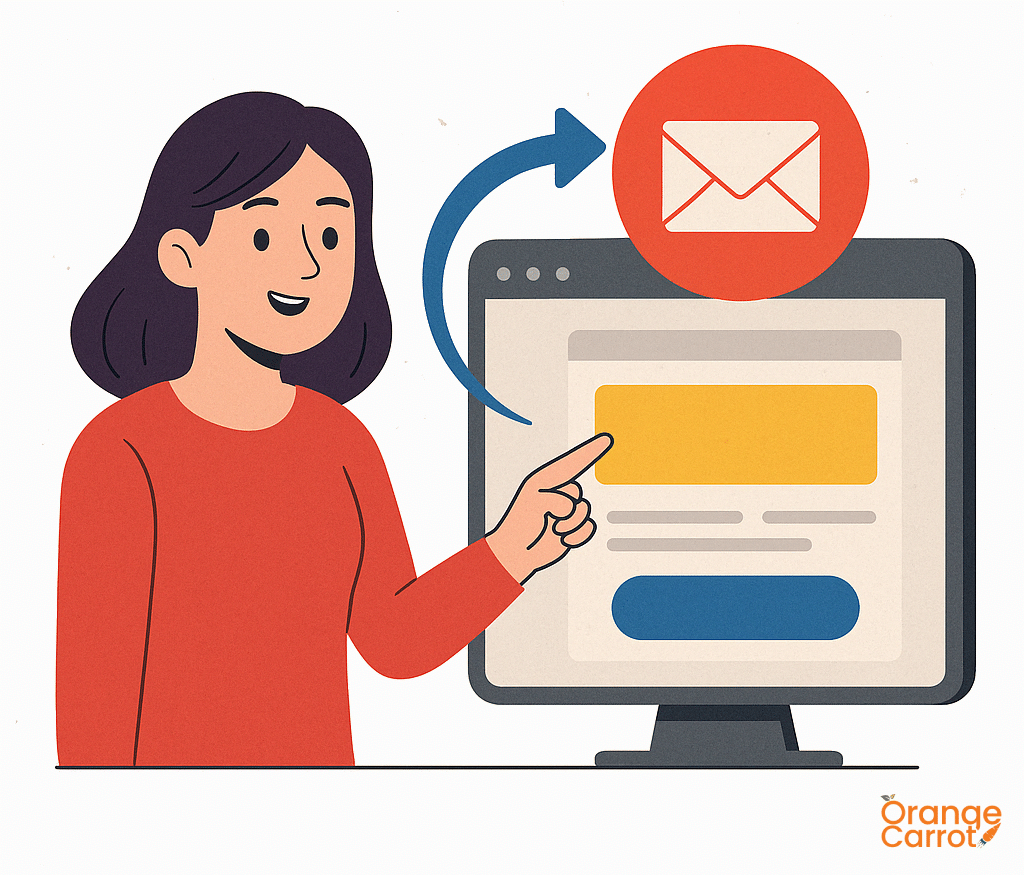
Not every visitor to your website or (click on the ads) becomes a patient right away. Some may browse your services, read about your doctors, or even begin the booking process — but leave without taking the next step.
That’s where AI-powered retargeting helps to re-engage with them.
Using advanced tracking and machine learning, AI can analyze visitor behavior to identify who showed strong intent but didn’t convert. Tools like Google Analytics studies patterns like which pages they visited, how long they stayed, and what actions they almost completed — such as starting a booking form or checking appointment availability.
Here’s a sample of how Google Analytics data looks like:
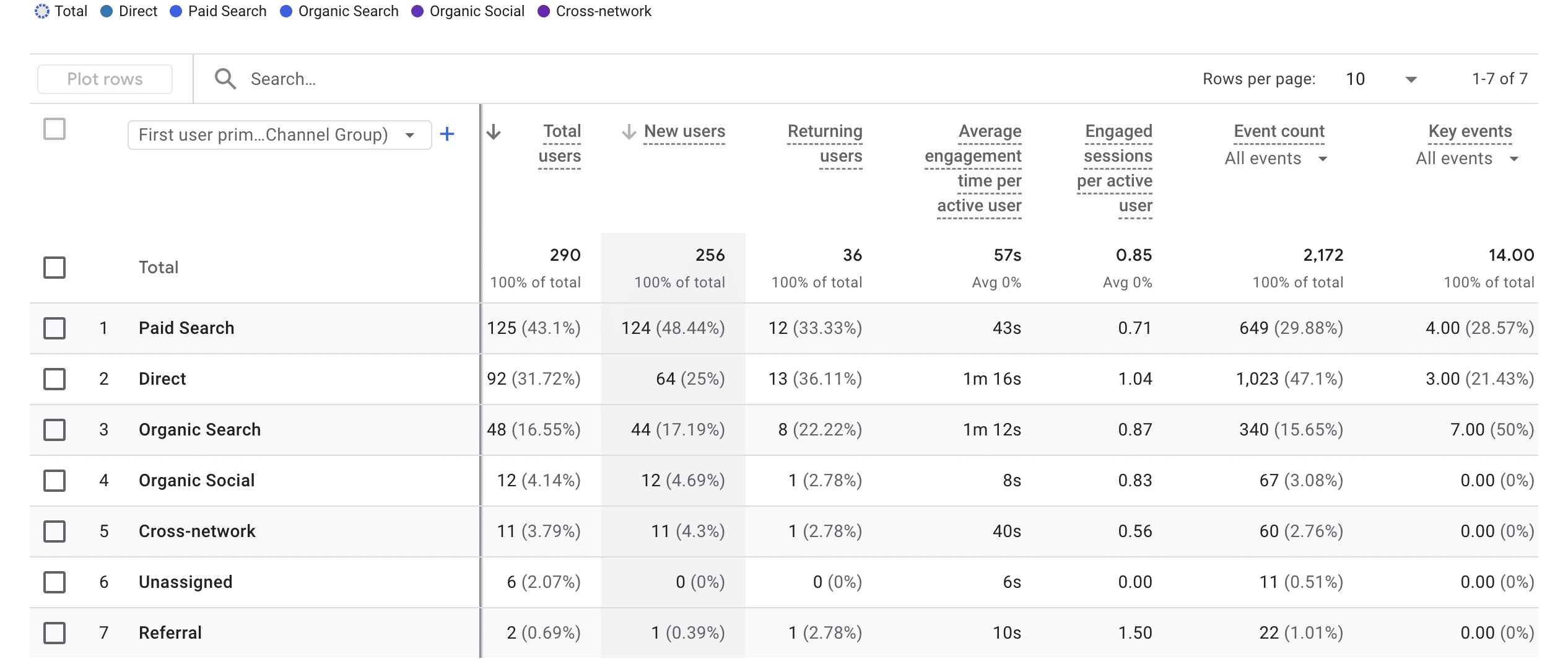
With these insights, our carefully-crafted marketing system automatically delivers highly relevant ads or emails to bring those users back.
For example, someone who viewed custom orthotics or heel pain treatment pages might see a reminder highlighting your expertise in those specific areas. The AI continuously refines this outreach by learning which messages, formats, and timing deliver the best results—improving efficiency with every interaction.
This level of smart retargeting helps ensure that interested prospects don’t slip through the cracks. Instead, they’re nurtured back into your patient funnel with messaging that feels personalized and helpful — not pushy.
For podiatry clinics looking to fill schedules and stay top of mind, AI-powered re-engagement is one of the most effective tools to win back lost opportunities.
Get an exclusive podiatry marketing plan for your practice. Book a free strategy call with us.
As clinics grow, administrative work often increases faster than revenue. AI can become a game-changing growth enabler by — automating time-consuming tasks, improving patient experience, and freeing up staff time for more strategic and human-centered responsibilities.
Whether you’re a new practice or an expanding multi-location podiatry clinic, understanding where and when to integrate AI tools can significantly boost operational efficiency and patient satisfaction.
Let’s look at how this can be achieved.
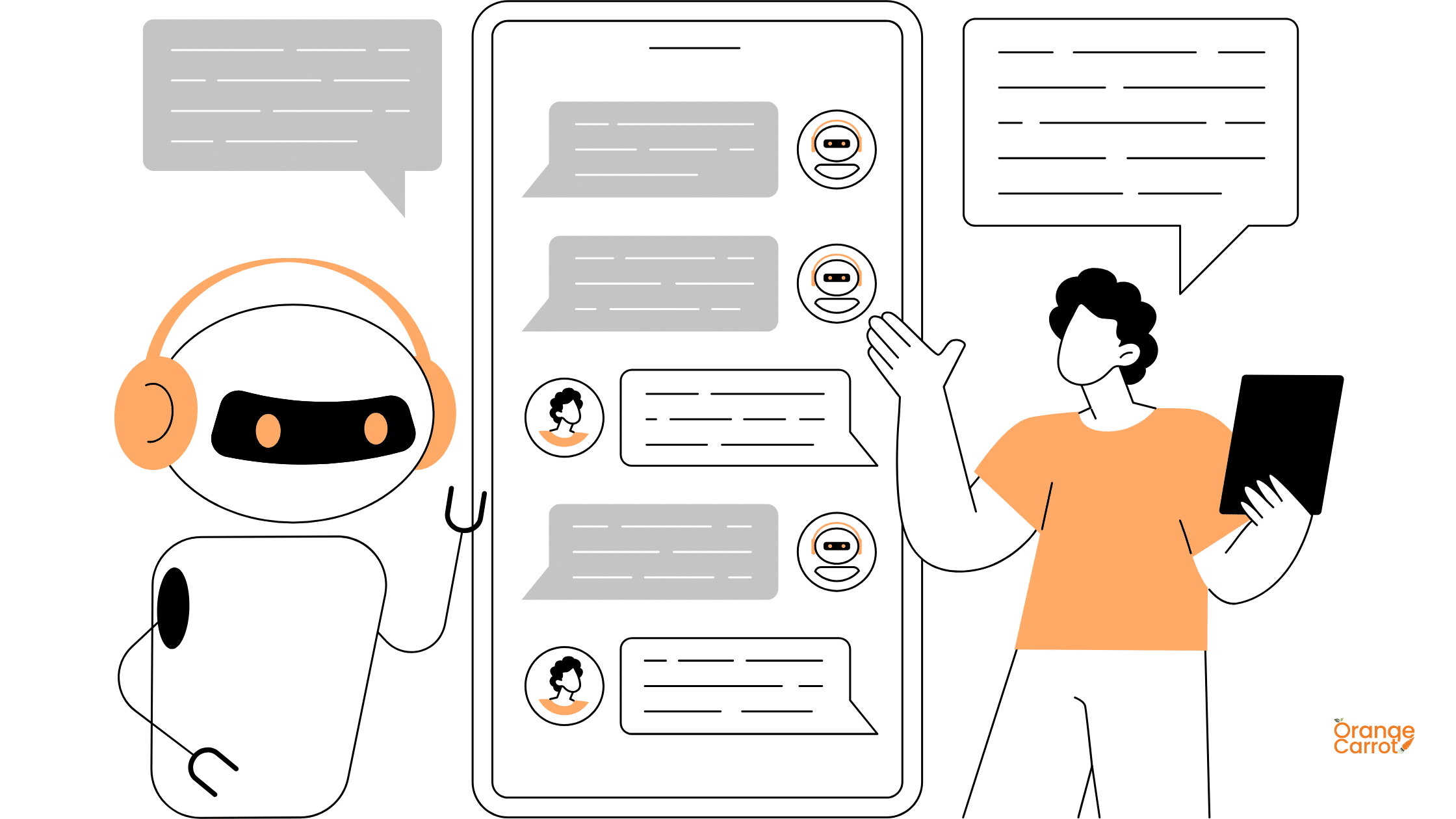
AI chatbots have emerged as the forefront of digital patient engagement today. They are available 24/7, can respond to a range of patient questions, and are extremely customizable to your practice’s requirements.
For small clinics or new practices, easy and inexpensive chatbot tools such as Tidio or ChatBot are great places to begin. These chatbots can be easily installed and provide basic functions such as:
At Orange Carrot, we developed our custom chat integrated with our software partners. So it would cost a lot less than the stand-alone AI chat apps. These tools require minimal technical setup and provide an immediate upgrade in the administrative works — especially valuable when staff are multitasking or after business hours.
The need for advanced tools:
While chatbots handle digital queries, a large volume of patient communication still happens over the phone — especially in older demographics or for urgent queries. That’s when AI-powered virtual receptionists can step in and manage phone traffic for your clinics.
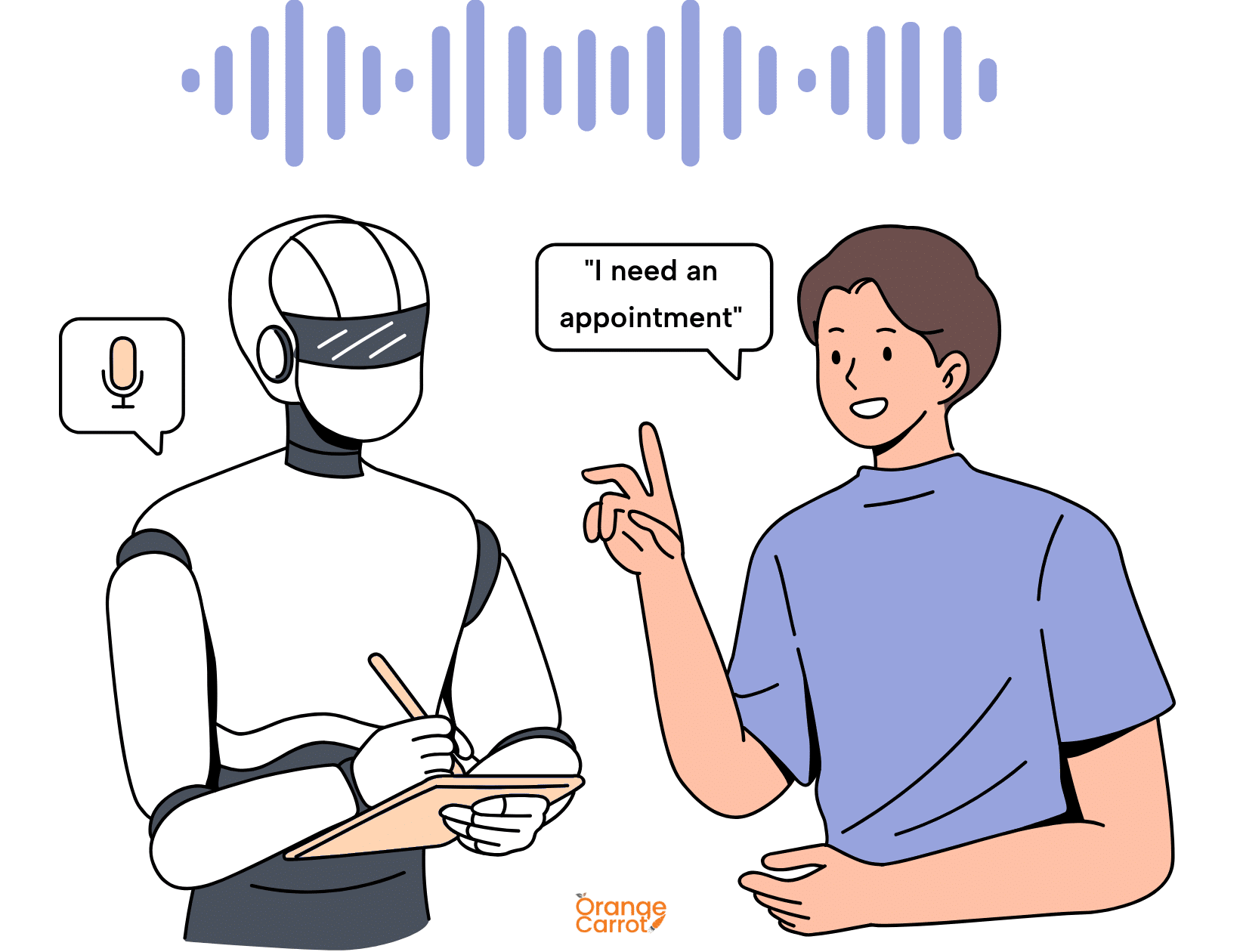
These ai tools can answer advanced queries like insurance and billing questions, handle appointment scheduling, reminders, and confirmations etc. And even offer multilingual support to cater to diverse patient bases. Although this has to be programmed during the initial technical setup phase.
As your practice scales, the need for deeper integrations and intelligent triage grows. Platforms like Infermedica offer AI-driven conversational experiences that go far beyond simple rule-based chatbots.
These platforms can:
For multi-location clinics or specialty practices, these advanced tools ensure patients receive fast, accurate, and personalized attention — without overwhelming human staff.
Pro Tip: Investing in chatbot analytics can provide insights into what patients are frequently asking about, helping to inform them of service offerings or content updates.
There’s measurable real-world ROI too.
Implementing AI call assistants has a direct impact on clinic operations:
The bottomline is, these tools are also a great asset to patients where they can get all the information at their fingertips before actually visiting your clinic. They have all the information to scale and plan their visit, expenses etc.
And for medical practices, scaling with AI doesn’t necessarily mean you need big budgets or a tech team. It’s about identifying where your clinic experiences bottlenecks — whether it’s patient queries, scheduling delays, or staff burnout — and deploying the right tool at the right stage of your growth journey.
Start simple, scale smart, and always prioritize the patient experience.
To build a sustainable growth for any podiatry practice, it is important to focus on important performance indicators that align with business goals. Rather than looking into just vanity metrics in any platform.
Below is detailed information about how and what tracking looks like across digital channels.
We’ll only list tools that the Orange Carrot team actively uses — ensuring all recommendations are based on our team’s firsthand experience
Your podiatry practice or clinic website serves as the digital front door for potential patients. Monitoring website traffic helps us understand how many users are reaching the site, where they’re coming from, and which pages they’re most engaging on.
This data will help the marketing team to make decisions for content marketing and advertising.
Tools Used: Google Analytics 4 (GA4), Google Tag Manager – there can be other tracking tools like Matomo but the Google tools are free to use. Plus, they offer valuable insights while still being free.
Some of the Key Metrics Tracked are:
For a deeper understanding, here’s how the typical online patient journey looks like:
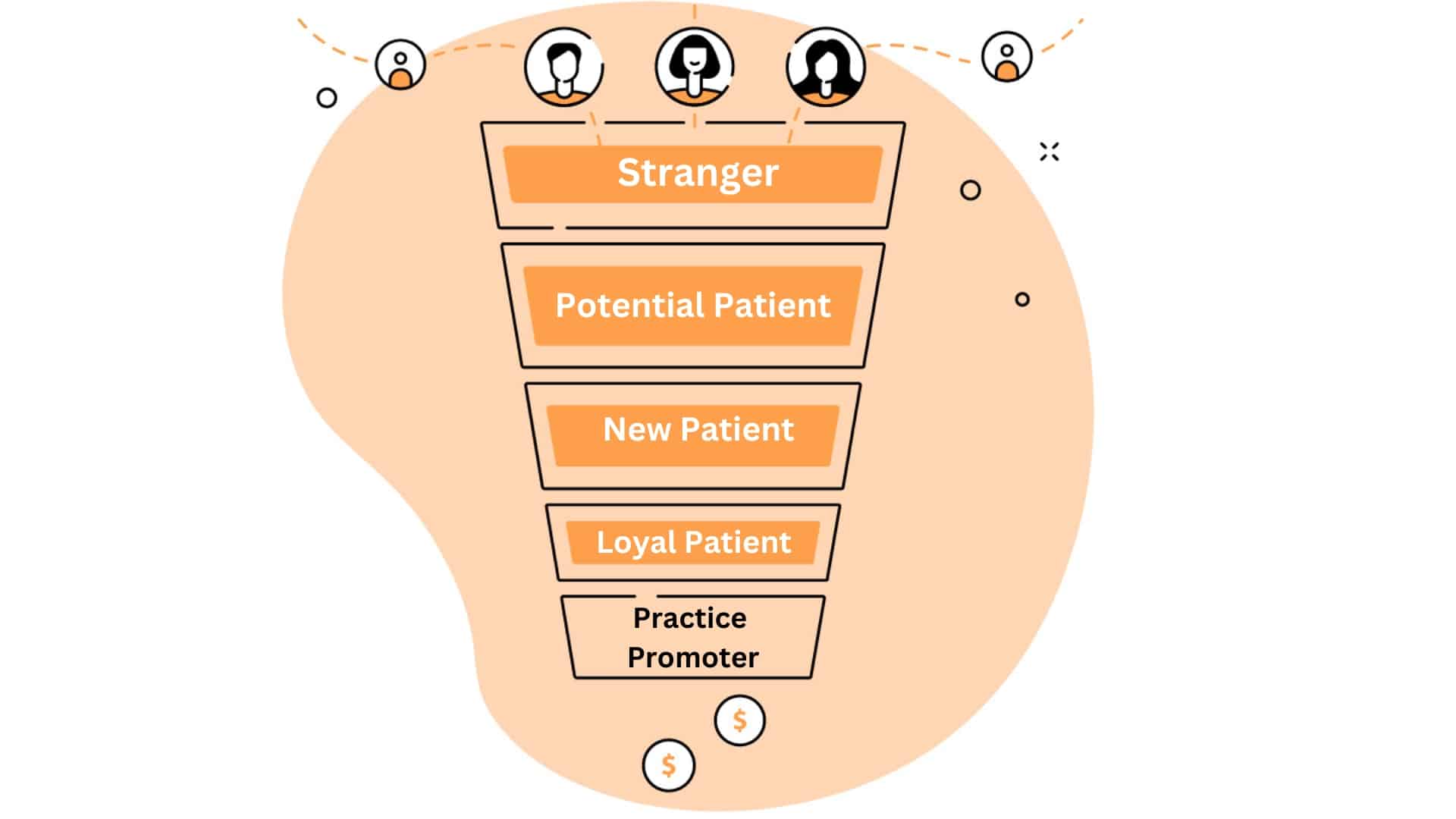
Why it matters: Identifying which pages or campaigns drive the most conversions helps refine both content strategy and user experience, ensuring we reduce bounce rates and increase bookings.
Organic search traffic is often one of the highest-intent traffic sources (along with PPC ads) for healthcare providers, including podiatrists. Patients typically search for conditions, treatments, or doctors before making a decision.
They do a thorough research about the symptoms, check the doctor reviews (reputation) before deciding to book a consultation.
Tools Used: Google Search Console, SEMrush/Ahrefs, BrightLocal
Key Metrics That can be Tracked by these Tools:
Why it matters: Ranking higher for service-related, localized keywords directly impacts inbound appointment requests without relying heavily on paid ads.
A well-run paid media campaign should have measurable ROI. It’s essential to track not just the number of leads generated, but how many actually turn into patients. This applies to both Google and Facebook (Meta Ads) platforms.
Tools Used: Google Ads Dashboard, Meta Ads Manager, CRM Integration (Zoho, HubSpot etc), Google Sheets
Key Metrics Tracked:
Why it matters: Tracking the full lead funnel allows us to adjust targeting, creatives, and budgets to maximize patient acquisition efficiently.
Note: Both organic and paid ads data can also be reported using Looker Studio (previously called Google Data Studio – an incredible free tool that offers good data insights)
Acquiring a patient is only the beginning. Long-term practice growth comes from patient satisfaction and word-of-mouth recommendations by them (patient loyalty). High patient satisfaction leads to better compliance, repeat visits if necessary (ideally you’d want patients to recover completely), and organic referrals — contributing directly to your long-term revenue.
By measuring retention rates, repeat visits, and lifetime value (LTV), you gain insights into how well your services are resonating and where there’s room to improve the patient experience.
Tools Used: CRM or Patient Management Software, Google Sheets, CallRail
Key Metrics Tracked by These Tools:
Why it matters: Understanding patient behavior post-visit enables better re-engagement strategies (an example is using the existing patient data to create look-a-like audiences for paid ads) and loyalty-building efforts like recall campaigns, check-up reminders, or targeted offers.
| Focus Area | Metrics Tracked | Tools Used |
| Website Performance | Traffic, session duration, bounce rate, bookings | GA4, Tag Manager |
| SEO | Keyword rankings, impressions, organic traffic | Search Console, SEMrush, BrightLocal |
| Paid Media | CPC, CPL, ROAS, CTR, lead-to-patient conversion | Google Ads, Meta Ads, CRM |
| Patient Retention | Repeat visits, LTV, feedback | CRM, Call Tracking |
Don’t get overwhelmed with the exhaustive list of strategies mentioned here. Our expert team at Orange Carrot can implement this and much more. We work hand in hand with your existing resources to implement – a phased, step-by-step podiatry marketing plan based on your clinic size, budget, and goals.
Share:
Download FREE Podiatry Marketing Plan Template